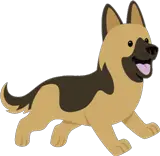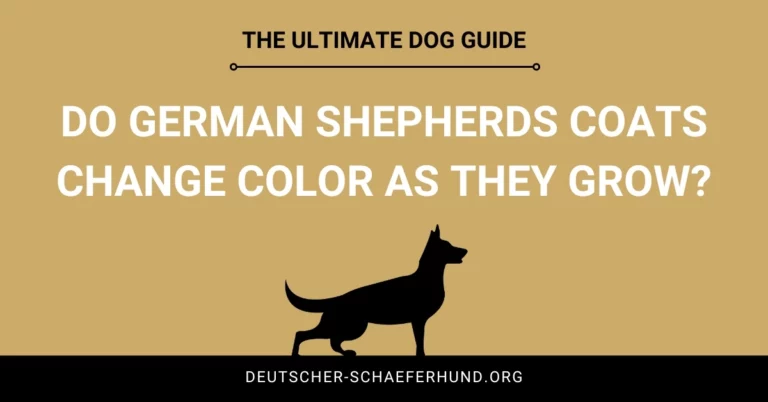There are many different colors of German Shepherds that are recognized by the American Kennel Club. Each color has its own specific traits and uniqueness.
However, there are some interesting facts about the coloring of German Shepherds that make them even more unique than some other breeds of dogs. German Shepherds are one of the few breeds of dogs whose puppies change color as they grow into adults.
This is a trait that is common in only a few other breeds of dogs, and it makes German Shepherds unique and extra interesting. These color changes can, however, make it challenging when you are puppy shopping, especially if you are looking for a particular color.
In this detailed article, we will take a look at the changing of the coats color of German Shepherds dogs. How you can groom them and take special care of their coats? As GSD age, the color of their coat will change gradually. Here are some common questions about the coloring of the German Shepherd dog.
 Written By Sergey Uhanov – Certified Veterinarian.
Written By Sergey Uhanov – Certified Veterinarian.
Sergey Uhanov is a certified veterinarian for dogs over 10 years, breeding 3 dogs. He loves dogs and has his own pet clinic in Israel. He likes to help other people with their dogs by sharing his experience and knowledge.
How Often Do German Shepherd Dogs “Change” Their Coat?
German Shepherd dogs will change their coat color fairly consistently from the time they are born until they are about 2 years old. This change in color is the most dramatic during the first 8 weeks of life.
During this time German Shepherd puppies will change from their birth color to the young coat that will resemble their coat as an adult. This means that their soft puppy fluff will change color for some breeds, and will also start to change in texture.
Over the first two years of life, your German Shepherd puppy will change its coat frequently. These changes will alter the coat color, growing in the color and pattern that your dog will possess for the bulk of its adult life.
During this time your German Shepherd will also lose the soft coat of a puppy, and grow a more dense, coarse coat of an adult. You will also start to see your puppy’s coat develop the distinct traits of the short, medium, or long coat.
Changes in coat length, coarseness, and color will progress during the normal pattern of molt. You will notice obvious patterns of shedding or molting in your German Shepherd, generally, two times per year.
Most dogs, molt during the fall and during the spring. Your German Shepherd puppy will also molt during these times, and until it is around 2 years old, you will notice changes in your dog’s coat color and texture.
Grooming
It is important that you are diligent during these times of molt with grooming your German Shepherd dog, especially if your dog is long-coated. German Shepherds, especially long coated German Shepherds, are prone to matting due to their coarse coat texture.
Matting can be painful for your dog, so make sure that you brush them often during these times of molting.
Good grooming of your German Shepherd during molt will also help to keep your home free from excessive amounts of hair.
Change in Color of Older German Shepherd Dogs
As your German Shepherd dog ages, you may notice that their coat will change as well.
The changes that you will notice in the color of your German Shepherd dog will be subtle and are similar to the coat color changes that most dog owners will notice with their pets.
You shouldn’t be alarmed to see that your German Shepherd is changing color as it ages. Just like people, German Shepherds will start to show a greying of hair as they age. You will notice this change, particularly around their eyes and muzzle.
This change will be particularly noticeable on German Shepherds that have dark faces, or on black German Shepherds.
Besides the graying of the face, you may notice that your German Shepherd’s coat becomes less lustrous and duller as they start to age. This change in their coat may make your German Shepherd look less colorful than they did as a younger dog.
Along with graying and a dulling of the coat, you may notice that your German Shepherd is losing more hair, and their coat seems thinner, as they get older. This, like a change in face colors and a duller appearance, are natural progressions of aging.
However, if you notice that these changes happen very rapidly, you may want to visit your veterinarian. Rapid changes in color or coat thickness can be an indication of a more serious problem.
If your German Shepherd starts losing hair in thick patches or has a rapid change in color this could indicate health problems like thyroid issues, cancer, or liver issues.
As a German Shepherd owner, you may not be able to stop the natural change in coat color as your dog ages, but you can take steps to help keep their coat soft and thicker as they age.
Adding fish oils and natural fats to your dog’s diet can help them retain more of their coat as they age, and can help keep a German Shepherd’s coat soft and shiny, despite their age.
German Shepherds are great family companions, and they have many unique traits that make them amazing, special dogs. Their coloring and change in color as they grow is one of the most interesting and unique features of the German Shepherd.
As we’ve learned, this change in color is well known within the German Shepherd community. However, it can make it more challenging if you are new to the breed and are looking to buy a puppy of a specific color.
In the long Run
Our advice when you are shopping for a German Shepherd puppy, in a specific color is to work with a reputable breeder.
Good breeders will be able to help a new German Shepherd owner or one that is looking for a particular color, find the right puppy to add to their family.
And remember, rapid changes in color can be a sign of serious health problems and should be addressed by your veterinarian.
However, it’s expected that your young German Shepherd will change color, losing their puppy coat and growing their adult coat, and older dogs will grey. These are the natural color changes you can expect with your healthy German Shepherd dog.



